
I’m thrilled to announce that one of the gardens I designed for a client is featured in this month’s Sunset magazine.
In today’s post, I thought I’d talk about another aspect of this garden – using the very-gray colored dymondia margaretae as a lawn substitute.
And not just the ground cover itself, but the tricks I use to keep the color looking lush.
But first, a little background and a few before & afters.
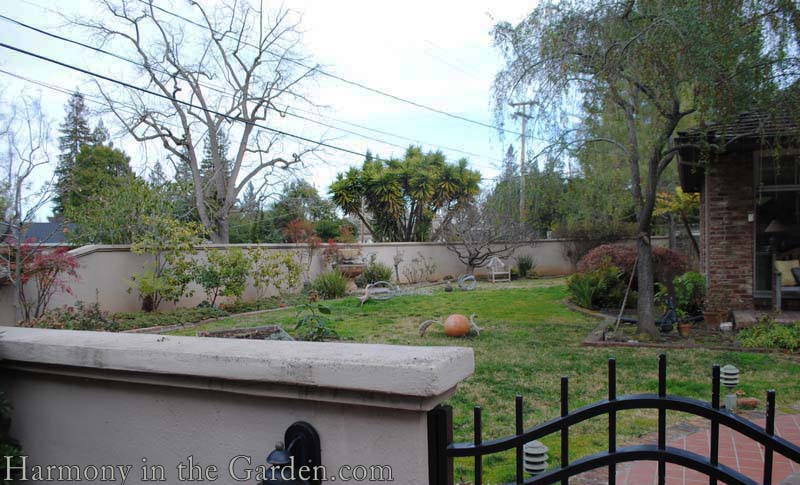

My client’s home is located on a busy corner within a stone’s throw of two nearby schools, giant picture windows throughout the house, and a low, 4-high wall surrounding most of the garden (a Lookiloo’s fantasy)!
What this translated into was the homeowners being on constant display to traffic and pedestrians, alike.
The lack of privacy would tempt many to build a fortress-like wall to surround the garden. But, staying true to their welcoming personalities, they decided to create a garden that others might equally enjoy.
After all, if they’re going to peek over the wall they might as well have something nice to look at, right?
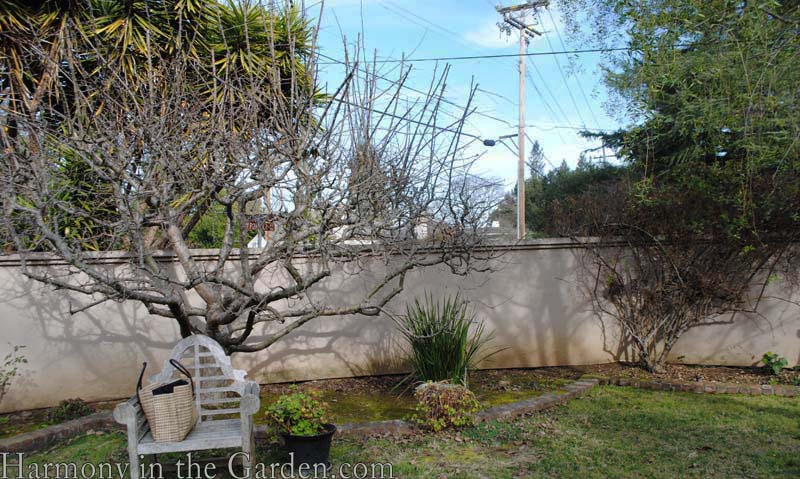
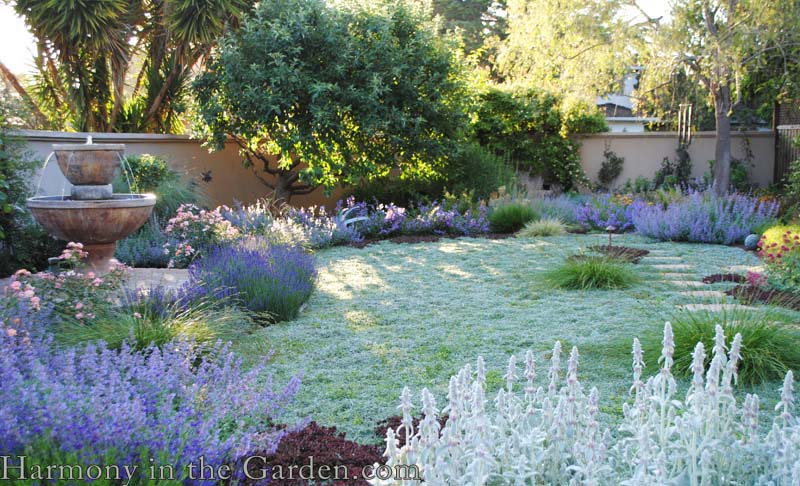
Tired of their threadbare, un-used, water-thirsty lawn, and random mishmash of plantings, they wished for a more responsible, fun, and ‘livable’ garden that not only used less water but incorporated plenty of native plants to encourage all types of wildlife to visit.
My first step was to rip out the lawn and reinterpret a newer, smaller version using dymondia. I chose dymondia because it’s extremely tough, drought-tolerant, evergreen, and can withstand a decent amount of foot traffic. Plus, it’s just so darn pretty.
Their concern, however, was that using such an expansive amount of gray in the garden would have a blinding, bright, and parched effect.
This is a perfectly valid concern, and one that I’ve often heard from other clients who have experienced unintended ‘glare’ in their own gardens as a result of an overuse of gray plants.
To help you avoid this common pitfall of using gray in the garden, here are a few tricks I’ve used to help tone down the brightness while still enjoying this fabulous foliage.
Shades of gray


First, it’s important to realize that there are different shades of gray ranging from light & bright, to mid-level gray, and all the way to dark, charcoal-like foliage.
And because of this range, not all grays are alike!
It’s perfectly okay to use plenty of gray plants in the garden as long as you vary the shading. No one really wants to look at one bright gray plant after another without a place for the eye to rest. Just remember to use plenty of mid-level and dark gray plants sprinkled throughout.
Keeping it lush
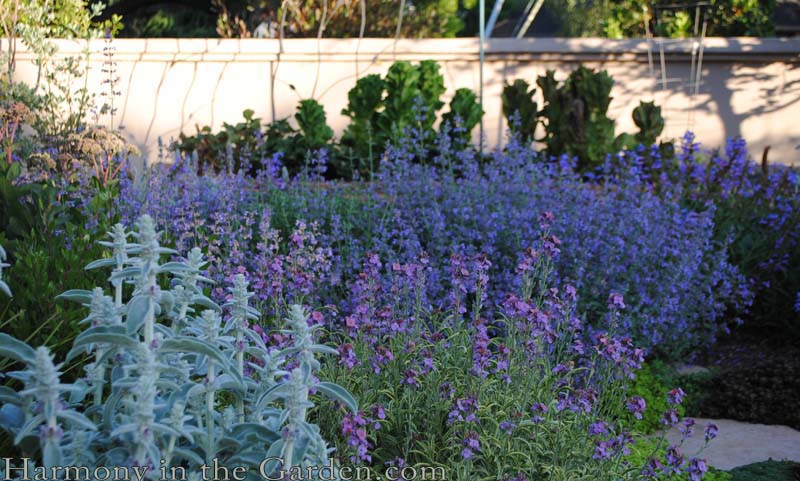
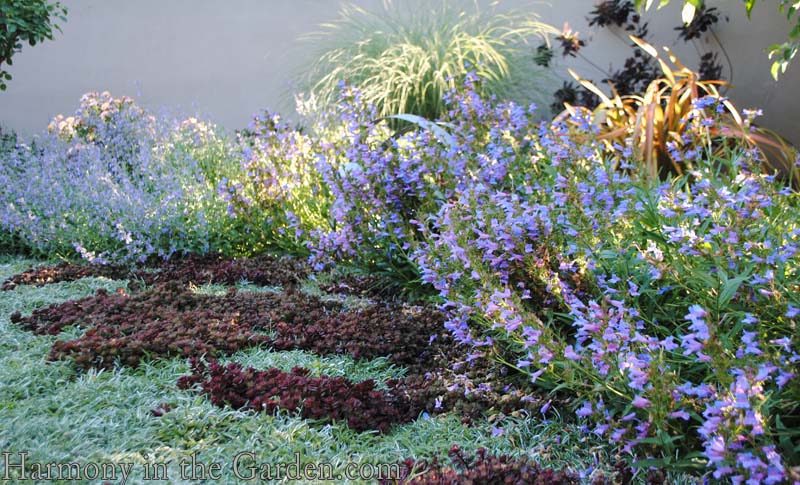
In order to prevent gray colors from creating a ‘pass the sunglasses’ effect in your garden it’s important to include plenty of nearby plants that have deep, rich colors, such as burgundy, green and purple.
In this garden, we included the brilliant blue flowers of our native ‘Blue Springs’ penstemon, vibrant purple lavender, and the deep burgundy stonecrop sedum that creeps throughout the edges of the dymondia lawn.
The Lamb’s Ear (in the above left photo) is used sparingly throughout the garden as it’s a really bright shade of gray, bordering on white, and could easily cause the dymondia to appear brighter than it actually is.
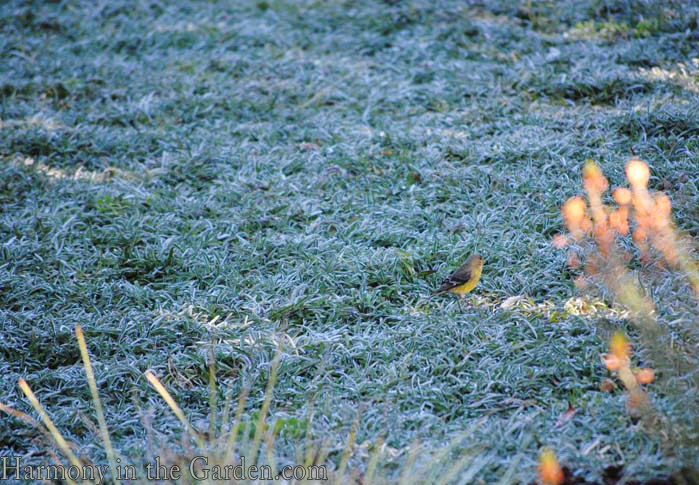
In fact, each dymondia leaf actually consists of two colors – green on the bottom and silvery gray on top.
And once the dymondia begins to grow and fill out (forming a soft and inviting 3″ spongy mat), its slender leaves will begin gently twisting, revealing its different colors.
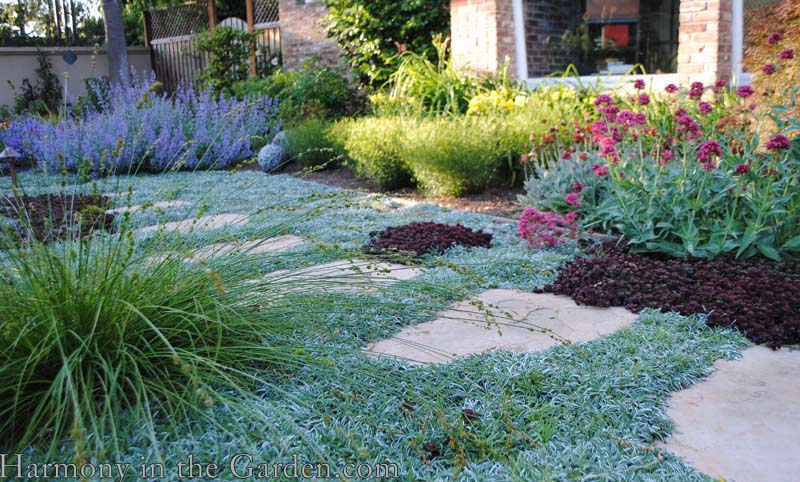
To further emphasize the green in the bi-colored foliage, I made sure to include plenty of other surrounding plants with green colors.
For example, I’ve interspersed our native Carex divulsa (Berkeley sedge) and Calamagrostis foliosa (Feather Reed Grass) throughout the lawn, as well as lots of perennials with green foliage.
It’s not just dymondia that has hefty amounts of green in its coloring – take a look at a lot of other gray plants and you’ll notice green beneath the gray ‘fuzz’ (ie: many lavenders, senecios and hostas).
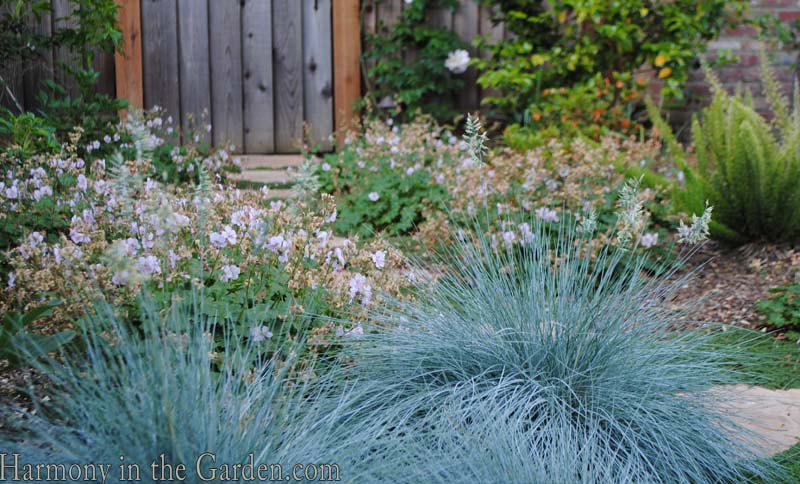
To emphasize the blue tones of the gray dymondia colors, I also included plenty of blue plants in the garden, as well.
For example, using ‘Beyond Blue’ fescue, various succulents, and lots of blue-flowered perennials.
My goal was to emphasize the tones and colors that I want while minimizing the tones that I don’t want.
Can you imagine how bright the garden would be if I had used an overabundance of white flowers and foliage?
Hardscaping
Hardscaping (such as nearby flagstones, patios and sidewalks) plays an important role when placed near gray plants as it, too, can serve to either tone down the brightness or amp it up to blinding proportions.
For this garden, we chose flagstones with slightly creamy-pink tones to them. Again, the reason was to de-emphasize the bright gray colors by introducing softer muted shades to tone things down.
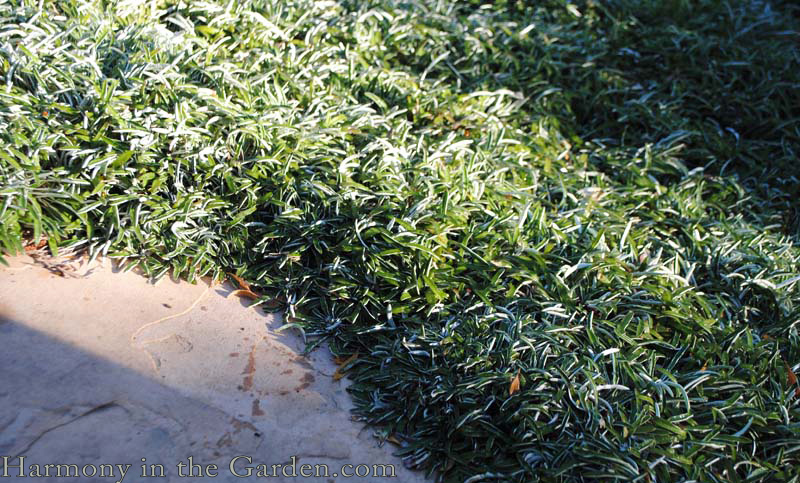
I’ve seen plenty of instances where a drift of bright gray plants, such as Lamb’s Ear or artemesia, have been placed directly adjacent to a bright white cement walkway.
And 9 times out of 10 that’s the area the homeowner is referring to when they say they don’t like the color gray.
To eliminate this blinding effect, just remember to use hardscaping with softer tones and/or darker colors.

And even though bright white Max isn’t doing much to help tone down the dymondia’s gray, he’s just so darn cute I can’t resist including him in this post.
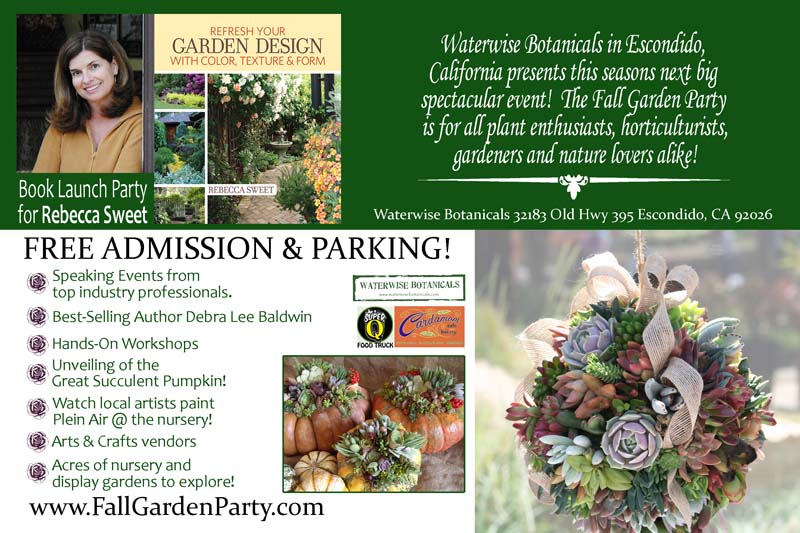
As a side note – for those of you who live in Southern California (or for those in need a fun vacation) you’re all welcome at my first official Book Launch Party graciously held at Escondido’s Waterwise Botanicals.
My latest book, Refresh Your Garden Design with Color, Texture & Form, is finally here, and I’ll be signing books as well as talking about using gray (and other ways to breathe life into your garden) on October 26th.
I hope to see some of you there!






42 Comments
Congratulations! Between the bunnies and the water company, even great lawn lovers that we are, next season just might see less turf here.
Rebecca…I am loving your newest book and all the ideas it is giving me! Thank you for putting this together! As for the dymondia “lawn”, what a great idea! The Sunset article is wonderful and to think this is a garden that I have driven by and admired many times. We have been very happy with the dymondia around our flagstones thanks to your encouragement to use it 3 years ago. The texture and gray-green tone are perfect for softening the hardscape and adding a nice contrast to the nearby flowering plants. Only you could have given us results so well done!!
What a sweet comment, Suzanne. Thank you so much! If you ever want a personal tour of the garden just let me know. Heck, you can even walk right in there and knock on the door – Pam and Mark are the most welcoming people and would love to show you around. Your dymondia definitely gave me the idea and I just took it and ran! So glad you’re enjoying my book, too! 🙂
Hi Rebecca, Your new book arrived today from Amazon. Congratulations! It’s full of ideas and practical advice. I’m looking forward to re-working some of my garden beds after finishing your book. Great photos, too, and I love the use of black & white photos to analyze the garden. Thanks so much for all your hard work.
Oh Anne – what a lovely email. I’m so glad it arrived and that you’re enjoying it. Thank you for taking the time to tell me this – made my day! 🙂
Fabulous design. WOuld love to see it in person!
Thank you so much, Jayne! If you’re ever out here, let me know and I’ll arrange a tour!
I was excited to see your garden in Sunset but this post was so much better. My copies of your new book are in the mail and I cannot wait to see them. I wish you lived closer to me. I would love a consult. After your class in Marin, I have begun ripping things out to refresh.
Thank you, Dot! I wish I could see your garden, too – I’m sure I’d be impressed (despite what you say!) I hope you enjoy my new book – definitely let me know what you think! p.s. I was thinking of you a few weeks ago when we drove by Donner Lake. It was a gorgeous, gorgeous fall weekend. I hope you can get up there soon!
I wanted to let you know that I have gone through the book multiple times and it is wonderful. I am gifting three of them to like-minded friends. Please let me know when you will be by Donner Lake. I would love to host you for a meal or cup of tea. If it is summer, you can enjoy my mountain garden. Have a great holiday season. After Christmas we are heading to Donner and I will be hunkering down with your books and redesigning the garden here in Marin.
Dot, what a wonderful message to receive – I’m smiling ear to ear! Thank you so much for the compliments – it makes me so happy to know you’re enjoying my book. And wow – three as gifts to friends? Thank you, thank you, thank you!! I’d love to visit you in Tahoe – wouldn’t we have fun? I will definitely make that happen, if not this winter (brrr….cold just thinking about it!) then definitely this summer. Maybe I could even bring my mother (she’s created quite a beautiful garden at our Tahoe house) who I know would love to see what you’ve created! Happy Holidays to you, too. XO
Oh, what a refreshing and beautiful design! And I’ll take to heart your wise perceptions on playing the shades of gray, green, and blue together.
What an absolutely refreshing and inspiring design! I will be taking your wise perceptions to heart and playing off the shades of gray, green, and blue. Just lovely!
Thank you so much, Linda! 🙂
What an incredible garden Rebecca and congratulations! I love your explanation for muting the grays. Very interesting. I have tried to grow Dymondia here in Sacramento but the hot summers just cook it like it is lit with a match. Very upsetting! Darn!
Thanks Candy! I’m so sorry Dymondia is such a wimp in your area – that’s surprising to hear! I thought it was a lot tougher than that. But then again, Sacramento is HOT in the summer. 🙁
Rebecca, I always look forward to your posts. The garden looks fabulous. Sincerely, Brent Freitas, Eye of the Day, Inc. 805-895-3007 http://www.eyeofthedaygdc.com
Thanks Brent! Some day soon I hope to write about the Coutre’s garden (and their to die for fountains, thanks to Eye of the Day!) 😉
The garden is stunning! I bought the Sunset magazine, but I love the back story you give, along with all of the details. Thank you.
Thanks Sara! I’m glad you liked it! 🙂
Thanks for the tips on using gray in the garden. I’ve already pre-ordered your book through Amazon and anxiously await its arrival. Really enjoy your blog.
Thanks so much, Anne. I appreciate the kind words and I hope you like my book! It should be arriving any day now – I’ve heard from a friend in Australia who already received hers. Hooray!
Shortly after moving into our current house 2.5 years ago, I put dymondia in as a groundcover in an area roughly 12 feet long and 6 feet wide. It has yet to fill in and I’m concerned that I spaced the plants too far apart (following instructions received with the flats I bought). Of course, periodic visits by grub-hunting raccoon didn’t help either. In any case, do you have a recommendations on spacing dymondia for full coverage?
Wow, Kris, it should definitely have filled in by now! Ours grew surprisingly fast, but then again it’s in the full sun and gets regular water (with really good soil underneath). Is your area in full sun? I’ve noticed dymondia isn’t really happy in the shade and I’m wondering if that’s whats happening to your area. We spaced our plugs about 12-15″ apart, btw.
Rebecca this garden is absolutely stunning!!
Thanks, Lisa! You’d love the homeowners – some of the sweetest and most fun people I’ve worked with! (like you!)
I just replaced our front lawn with dymondia in the sun and dwarf mondo grass in the shady parts – can’t wait until it fills out like in your Gorgeous pictures! Beautiful job Rebecca!!!
Good for you, Jeanne! I’m sure it’ll look fantastic. The dymondia that we planted grew unbelievably fast – hope you have the same result!
Beautiful and thoughtful garden design and I love your tips since I have a lot of gray in my garden. Many of the plants which work best in my hot, dry climate are gray and your approach is helpful for areas where I need to tone it down a bit.
Thank you for making the “garden of our dreams” come true. It is a “new painting” to view each season and I have more bees, butterflies and birds than ever. We have met more neighbors who just have to stop and admire. You are an incredible designer who was a joy to work with.
Oh Pam – you know you’re a HUGE part of why your garden turned out so well. The best gardens are always a combination of both the client and the designer. You and Mark were (are!) a dream to work with! XO
Oh, oh, let’s do mine! This is a lovely garden and your explanation of the way to use grays is very helpful. As a mostly unrelated side note, our endeavors of last fall with accompanying installation of drip irrigation radically reduced our water usage this year. Can’t wait for your book to ship!
Hi Jo! I’m so glad to hear you’ve seen a noticeable drop in your water bill, too. Hooray for good irrigation and non-thirsty plants! I’ll have a sweet little Kangaroo Paw to drop off at your home next week, to join your garden! 😉
Well done, RS! I enjoy seeing your work, especially how to use gray that isn’t depressing. Your “include plenty of nearby plants that have deep, rich colors…” is key, as is that 3rd row of before-after…the after on the right really works to draw a person in any time of year, especially in that light.
Thanks, David – I always appreciate your comments. Coming from such a hot environment as Arizona and now Texas I know you’re all too familiar with the true hot, parched desert-y look that gray can give to an already hot garden. 😉
This is so gorgeous – I love the purples, greens and grays together. You are giving me something the think about and plan for in our new garden when we come back home to California! A question – are gophers an issue for this garden? Thanks so much.
I’m so glad you like it, Karen! Gophers are EVERYWHERE in my area (fun fact: during the turn of the century Los Altos was known as ‘Gopherville’ – how’s that for depressing!!) but luckily they’ve only invaded her garden once. It took her awhile, but she finally got the little bugger. She tried to be as accommodating as she could without harming the gopher, but I think she finally had to call a professional to come in and do his dirty work. Knock on wood that’s the only problem she’ll encounter!
Yes, great tips. I’m certainly guilty of overdoing the silvery plants, due to over enthusiasm, but you’ve explained really well how to mediate this. You’re good at explaining things! Can’t wait to get my hands on your new book!
Love the helpful tips, Rebecca, on using one of my favorite summer-cooling colors in the garden.
Thanks, Pam! I would imagine you’d know best when it comes to including summer-cooling colors in your Austin garden! 😉
What is the taller grey plant. It looks like an artemisia but
Taller than I have ever seen. I am a floral designer and would love to know
Its name. Thanks
Hi Margaret – I think you’re referring to the stunning Silver Lace Bush (tanacetum ptarmiciflorum). It can be hard to find here in Northern California, but Annie’s Annuals has carried it, off and on, in the past. Here’s a link if you’re interested: http://www.anniesannuals.com/plt_lst/lists/general/lst.gen.asp?prodid=1053